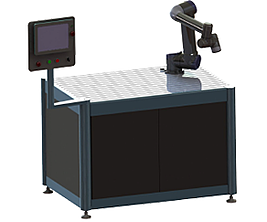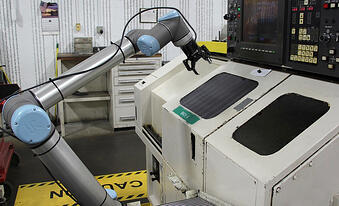What the Heck is Robotic Machine Tending Anyway?

Posted on May 19, 2015 in Robotics
5 min read time
You may have heard several terms many times in all its declensions: CNC machine tending, robotic machine tending, autonomous machine tending. Whatever terminology you are using it is pretty much the exact same action that is being performed. But what does it all mean and how it is done? The following article is about the different types of machine tending and how it is achieved.
The basic definition of tending is: the work of providing treatment for someone or something. In this particular case machine tending would be to load and/or unload a given machine with parts or material. Currently most of the applications involving machine tending are done by humans. Most machine shops are using their human workforce to load and unload machines and to restart the program once the finished part is out of the way. However, since qualified workers are becoming harder and harder to find, companies are introducing robots into their workshops to make up for the lack of employees.
The most popular applications of machine tending would be in machine shops where robots would load raw material, the machine then executes its program, the robot takes the finished part out and loads the machine with another raw part. This process can be done in a loop for an infinite number of times assuming the robot continually receives raw parts and that the machine produces quality parts.
Some industries use robots just to do a piece of their production like emptying injection molding machines. When the cycle time is important and production is running around the clock, you may want to have a robot that removes the parts from the mold to run the machine continuously.
How to Achieve Machine Tending for a Small Shop?
Most machine shops with workforce problems are SMEs and have a minimum budget with which to introduce robots into their shops. The other limiting factor is that these kinds of shops often have more than one production process and low volume production as well, so the usual paradigm is to think that a robot is only made for large continuous productions. Well, nowadays, robots are becoming more flexible and easy to program. This means that even a small production run can be relatively painlessly accomplished by a robot. Hand-guiding, flexible robot arms and adaptive grippers can be the key to success in small shops.
The robot and gripper can carry various size and shapes and load them into the machine. The robot can be reprogram in a few minutes and the human worker can focus on the quality assurance for the product and preparing the next setup instead of loading the machine him/herself, watching the machine and waiting for the end of the program.
What is the Starting Investment for a Machine Tending Cell?
There are various choices of machine tending cells. A couple of options can be looked at, here is a short list:
- The 'do it yourself' kit: You can build your own custom cell using a collaborative robot, an end effector and custom fit it to your actual setup. This option is probably the cheapest option with robots down to $25k , relatively cheap grippers (+/- $5k) and no safety guarding. Programming can be done by hand-guiding, this setup is easy to integrate and can have a fast payback (usually less than a year).

- The 'I don't want to spend time with integration' kit: Some robot manufacturers and robot integrators are offering pre-engineered machine tending cells. Either using a collaborative robot or an industrial robot, the kit come with everything you need for your machine tending application. However, the price of these systems can rise quite fast due to all the accessories needed and the integration time. I don't think you can have this type of system set up for under $50k and arrive at a complete solution. Still the setup remains relatively small and payback can still be quite fast.

- The 'all in one' kit: Now we are talking about a huge investment. In fact, if you want to have a robot that will handles many steps for your CNC machine or carry a huge part, an increased price will come with it. This setup will use industrial robots. You will need to have safety guarding, a dedicated space for the machine tending cell, as well as someone to program and synchronize all of this. I know that some companies offer built-in programming kits that are getting easier and easier to program, but it is still a huge investment in time and in your worker to train them on how to work the robot. These kinds of cells start at $100K and there is basically no upper limit. You can introduce all the fancy accessories you could ever think of. This kind of cell has to be introduced by a qualified integrator to be functional.
As you can see there are various ways and degrees to automated machine tending. Even if the principles remain the same, the variations cover a wide selection of possibilities. You may want to determine your needs first before going all out and buying a bunch of things which might complicate your process more than improve it. I suggest you read our eBook titled ''Step by Step Guide for Machine Tending''. This will give you a better idea of where to begin and the different steps you’ll need to go through to have a solid functional robotic cell.









Leave a comment